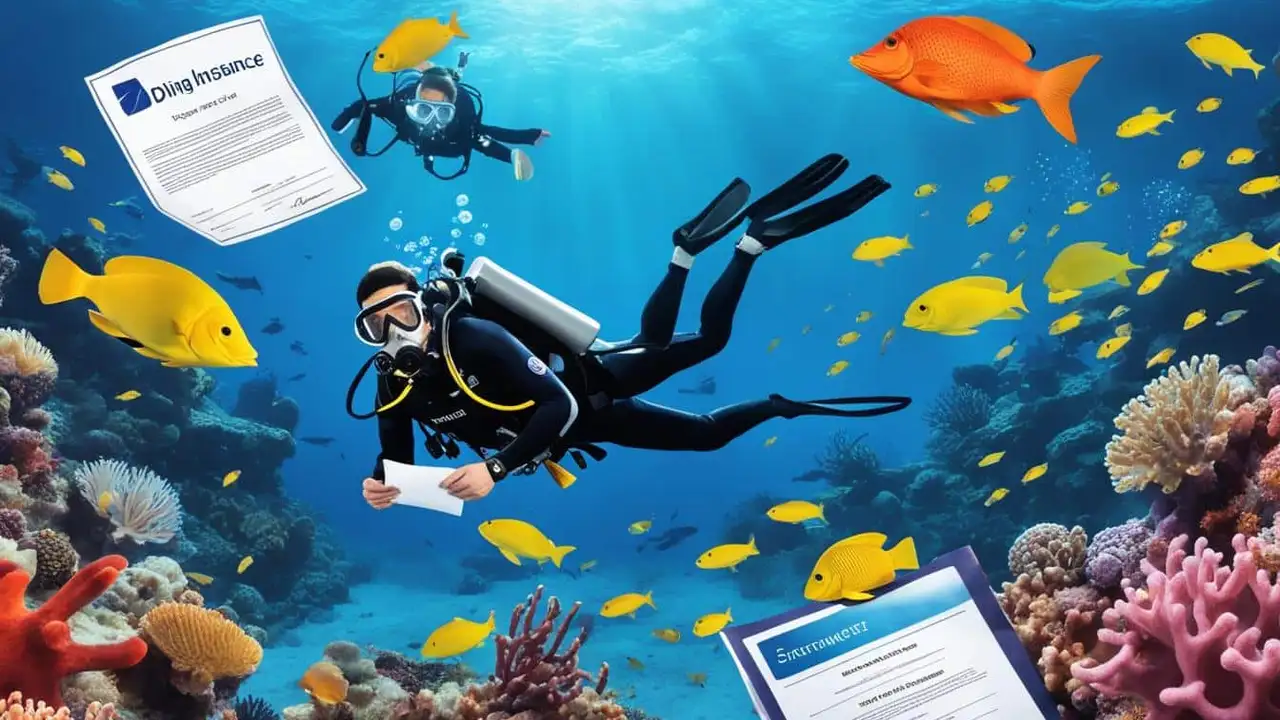Choosing the Right Dive Insurance Coverage Limits
Protect yourself underwater with the right dive travel insurance. We review the top 7 plans for US divers. Get coverage for diving accidents, medical emergencies, and equipment.

Understanding Dive Insurance Coverage Limits and Scuba Diving Risks
So, you're planning a scuba diving trip? Awesome! Crystal clear waters, amazing marine life – what's not to love? But before you jump in, let's talk about something super important: dive insurance coverage limits. It's not the most exciting part of planning, but trust me, understanding this can save you a *lot* of headaches (and money) down the road. We are going to dive deep into the world of dive insurance limits and help you make the best choice for your needs.
Why Are Dive Insurance Coverage Limits Important for Scuba Divers?
Think of dive insurance as your safety net. Scuba diving, while incredible, comes with inherent risks. Decompression sickness (the bends), marine life injuries, equipment malfunctions – these things can happen. And if they do, medical bills, emergency evacuations, and equipment replacement costs can quickly add up. Coverage limits dictate how much your insurance company will pay out in the event of a claim. Choosing the right limits ensures you're adequately protected against potential financial burdens.
Factors to Consider When Selecting Dive Insurance Limits for Scuba Diving
Okay, so how do you figure out the right coverage limits for *your* dive trip? Here are some key factors to consider:
Destination: Diving in the USA vs. International Scuba Diving
Where are you going? Medical costs vary wildly from country to country. A simple doctor's visit in the US might cost a few hundred dollars, while the same visit in a remote island location could be significantly more. Also, some countries have reciprocal healthcare agreements with the US, while others don't. Research the average medical costs in your destination to get a realistic idea of potential expenses. Diving in the USA generally has lower medical expenses compared to diving internationally.
Type of Diving: Recreational Scuba Diving vs. Technical Diving
What kind of diving will you be doing? A shallow reef dive is different from a deep wreck dive or a technical dive involving multiple tanks and decompression stops. Technical diving carries a higher risk of decompression sickness and other complications, potentially requiring more extensive medical treatment. Consider the complexity and risk level of your planned dives when choosing your limits. Recreational scuba diving usually requires less coverage than technical diving.
Medical History: Pre-Existing Conditions and Dive Insurance Coverage
Do you have any pre-existing medical conditions? Some insurance policies may exclude or limit coverage for conditions you already have. Be upfront about your medical history and choose a policy that adequately covers any potential complications related to your pre-existing conditions. Some policies offer riders or add-ons to cover specific pre-existing conditions. Dive insurance for pre-existing conditions can be more expensive but provides necessary protection.
Emergency Evacuation: The Cost of Medical Evacuation for Scuba Divers
Emergency evacuation can be one of the most expensive aspects of a dive accident. If you need to be airlifted to a hospital or transported to a hyperbaric chamber, the costs can be astronomical, especially from remote locations. Consider a policy with high emergency evacuation limits, particularly if you're diving in a remote area. Medical evacuation insurance is crucial for serious diving accidents.
Equipment Coverage: Protecting Your Scuba Diving Gear
Your dive gear is an investment. If your equipment is lost, stolen, or damaged during your trip, you'll want to be able to replace it. Check the policy's equipment coverage limits and ensure they're sufficient to cover the value of your gear. Some policies may have separate limits for specific items, such as cameras or computers. Don't forget to document the value of your scuba diving gear.
Understanding Different Types of Coverage Limits in Dive Insurance
Dive insurance policies typically have different coverage limits for various types of expenses. Here's a breakdown of the most common types:
Medical Expense Limits: Coverage for Scuba Diving Injuries
This is the maximum amount the policy will pay for medical treatment related to a diving accident. It's crucial to have adequate medical expense limits, especially if you're diving in a country with high medical costs. Consider policies with at least $100,000 in medical expense coverage, and even higher if you're diving in a remote or expensive location. Medical expense limits are the most important aspect of dive insurance.
Emergency Evacuation Limits: Coverage for Medical Evacuations
As mentioned earlier, emergency evacuation can be incredibly expensive. Look for policies with high emergency evacuation limits, ideally $100,000 or more. Some policies may even offer unlimited emergency evacuation coverage. Emergency evacuation coverage is essential for remote diving locations.
Trip Cancellation Limits: Protecting Your Dive Trip Investment
If you have to cancel your trip due to illness, injury, or other covered reasons, trip cancellation insurance can reimburse you for non-refundable expenses. Check the trip cancellation limits and make sure they're sufficient to cover the cost of your flights, accommodation, and dive packages. Trip cancellation insurance protects your financial investment in the trip.
Equipment Loss or Damage Limits: Coverage for Damaged Scuba Diving Gear
This covers the cost of repairing or replacing your dive gear if it's lost, stolen, or damaged during your trip. Check the policy's equipment coverage limits and make sure they're sufficient to cover the value of your gear. Some policies may have deductibles or depreciation clauses. Equipment loss or damage coverage protects your scuba diving equipment.
Dive Insurance Product Recommendations and Comparisons
Now let's get to the good stuff – specific dive insurance products you can consider. Remember to always read the fine print and compare policies carefully before making a decision. Here are a few popular options:
Divers Alert Network (DAN): Comprehensive Dive Insurance Plans
DAN is a well-known and respected organization in the diving community. They offer a range of dive insurance plans with various coverage levels. Their plans typically include medical expense coverage, emergency evacuation coverage, and equipment coverage. DAN insurance is a popular choice among scuba divers. * **DAN Master Plan:** Offers high coverage limits, including $500,000 for medical expenses and unlimited emergency evacuation. * **DAN Preferred Plan:** A more affordable option with lower coverage limits, suitable for recreational divers. * **Price:** Plans range from $129 to $399 per year, depending on coverage levels.
DiveAssure: Specialized Dive Insurance Coverage
DiveAssure is another reputable dive insurance provider. They offer specialized dive insurance plans that cover a wide range of diving-related incidents. Their plans often include coverage for hyperbaric chamber treatment, repatriation, and legal assistance. DiveAssure is known for its specialized dive insurance coverage. * **DiveAssure Platinum Plan:** Offers comprehensive coverage, including $250,000 for medical expenses and $100,000 for emergency evacuation. * **DiveAssure Gold Plan:** A mid-range option with lower coverage limits, suitable for most recreational divers. * **Price:** Plans range from $99 to $299 per year, depending on coverage levels.
Travel Guard: Standard Travel Insurance with Dive Coverage
Travel Guard is a well-known travel insurance company that offers standard travel insurance plans with optional dive coverage. Their plans can include medical expense coverage, trip cancellation coverage, and equipment coverage. Travel Guard is a reliable provider of standard travel insurance. * **Travel Guard Preferred Plan:** Offers comprehensive travel insurance coverage with optional dive coverage add-ons. * **Travel Guard Essential Plan:** A more basic option with lower coverage limits, suitable for budget-conscious travelers. * **Price:** Plans range from $79 to $249 per trip, depending on coverage levels and add-ons.
World Nomads: Adventure Travel Insurance for Scuba Diving
World Nomads specializes in adventure travel insurance, including coverage for scuba diving. Their plans are designed for adventurous travelers and often include coverage for a wide range of activities. World Nomads is a popular choice among adventure travelers. * **World Nomads Explorer Plan:** Offers comprehensive adventure travel insurance coverage, including scuba diving. * **World Nomads Standard Plan:** A more affordable option with lower coverage limits, suitable for less risky activities. * **Price:** Plans range from $89 to $269 per trip, depending on coverage levels and duration.
Scenarios: Examples of Dive Insurance Coverage in Action
Let's look at a few scenarios to illustrate how dive insurance coverage limits can come into play:
Scenario 1: Decompression Sickness in the Caribbean
You're diving in the Caribbean and develop decompression sickness. You need to be treated in a hyperbaric chamber, which costs $5,000 per treatment. You require three treatments. Your DAN Master Plan covers the full cost of the treatments because it has high medical expense limits. Without adequate insurance, you'd be facing a $15,000 medical bill. Decompression sickness treatment can be expensive, highlighting the need for adequate coverage.
Scenario 2: Emergency Evacuation from a Remote Island
You're diving on a remote island in Indonesia and suffer a serious injury. You need to be airlifted to a hospital in Singapore, which costs $50,000. Your DiveAssure Platinum Plan covers the full cost of the evacuation because it has high emergency evacuation limits. Without adequate insurance, you'd be facing a massive financial burden. Emergency evacuation from remote locations requires high coverage limits.
Scenario 3: Lost Dive Gear in the Maldives
Your dive gear is lost during a transfer in the Maldives. Your gear is worth $3,000. Your Travel Guard Preferred Plan covers the cost of replacing your gear, up to the policy's equipment coverage limits. Without adequate insurance, you'd have to pay out of pocket to replace your gear. Lost dive gear can be a significant expense without insurance coverage.
Tips for Choosing the Right Dive Insurance Coverage Limits
Here are some final tips to help you choose the right dive insurance coverage limits for your needs:
* **Do your research:** Compare different policies and coverage levels carefully. * **Read the fine print:** Understand the exclusions and limitations of each policy. * **Consider your destination:** Research the average medical costs in your destination. * **Assess your risk level:** Consider the type of diving you'll be doing and your medical history. * **Choose adequate limits:** Select coverage limits that are sufficient to protect you against potential financial burdens.Choosing the right dive insurance coverage limits is an essential part of planning a safe and enjoyable scuba diving trip. By considering the factors outlined above and comparing different policies carefully, you can ensure you're adequately protected against potential financial risks.
:max_bytes(150000):strip_icc()/277019-baked-pork-chops-with-cream-of-mushroom-soup-DDMFS-beauty-4x3-BG-7505-5762b731cf30447d9cbbbbbf387beafa.jpg)






